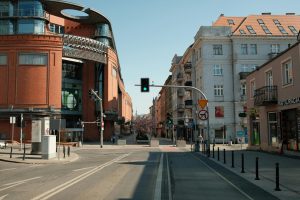Post-Plastic Cities: Building with Algae-Based Materials and Recycled Tech
In recent years, the use of non-recyclable plastics in construction has become a growing concern, as it contributes significantly to the world’s pollution problem. Cities, being the most populous areas, are at the forefront of this crisis, with towering skyscrapers and sprawling infrastructure made mostly of plastic. However, a new wave of sustainable construction is about to change the landscape of these cities – one that uses algae-based materials and recycled technology. Let us dive into the emerging trend of building post-plastic cities and how they are paving the way towards a greener future.
The Rise of Post-Plastic Cities
As urban areas continue to expand and population increases, so does the demand for construction materials. According to the United Nations, construction and building-related activities are responsible for 38% of global energy use and 36% of CO2 emissions. This alarming statistic has led to the rise of post-plastic cities, aimed at reducing the negative impact of construction on the environment.
The Impact of Plastic in Construction
Plastic is widely used in the construction industry due to its versatility, durability, and affordability. However, its production and disposal have significant consequences on the environment. Plastic construction materials are non-biodegradable, meaning they take hundreds of years to decompose, if at all. Improper disposal of plastic waste also leads to land and water pollution, harming both human health and wildlife.
Building with Algae-Based Materials
Algae, often seen as a pesky plant, has now become a sought-after material in construction. Researchers have discovered that algae can be used to create sustainable biomaterials that are not only strong and durable but also biodegradable. These materials are produced through fermentation, which uses algae as a building block instead of traditional petroleum-based materials. Algae-based materials can be used for various construction projects, from walls and roofs to floors and facades.
One of the primary reasons why algae-based materials are gaining popularity in post-plastic cities is their ability to absorb carbon dioxide during the production process. This makes them a more ecological alternative to traditional building materials, which contribute to the emission of harmful greenhouse gases.
Incorporating Recycled Tech in Construction
Another significant aspect of building post-plastic cities is the incorporation of recycled technology in construction processes. With advancements in technology, waste materials such as plastic, glass, and electronic devices can now be harnessed and converted into usable materials for construction.
Recycled Plastic Blocks
Researchers have developed a new type of plastic block that is made from 100% recycled plastic waste. These blocks are lightweight, affordable, and can withstand heavy loads, making them suitable for use in various construction projects. Unlike traditional bricks, which require high temperatures and emit harmful gases during production, recycled plastic blocks can be created using a low-energy and low-emission process.
3D Printing with Recycled Plastic
3D printing has also emerged as a revolutionary technology in the construction industry, using 70% less material than conventional methods. This technology offers endless possibilities for building post-plastic cities, as it can produce complex and customized shapes that traditional construction methods cannot. In addition, 3D printing also allows for the use of recycled plastic, reducing the need for new materials and decreasing waste.
The Future of Post-Plastic Cities
With the rise of post-plastic cities and the adoption of sustainable construction practices, the future looks promising for our environment. Apart from reducing the negative impact of construction on the planet, these cities also offer a more eco-friendly and healthy living environment for its inhabitants. As more countries and cities start to implement stricter regulations and promote the use of sustainable materials, it is only a matter of time before we see the widespread adoption of post-plastic cities.
Embracing Change for a Greener Future
In conclusion, post-plastic cities are a testament to our ability to innovate and adapt to protect the environment. Through the use of algae-based materials and recycled technology, we can create sustainable and eco-friendly urban areas that are not only beneficial to the planet but also to our well-being. It is time for us to embrace this change and build a greener future for generations to come.











